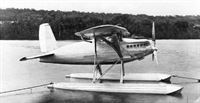Фотографии
-
At least six NiD 121C1s and four Potez 390A2s (A2 refers to the French Artillerie Biplace - two-seat observation aircraft - specification designation) are visible in this rare photograph of a CAP ceremony at Las Palmas airfield in September 1936.
Самолёты на фотографии: Nieuport-Delage Ni-D-121 - Ni-D-125 - Франция - 1932Potez Potez 37 / 39 / 49 - Франция - 1930
-
The Hispano-Suiza 12Xbrs-powered Nieuport-Delage NiD 122C1 at the Centre d’Essais de Materiels Aeriens at Velizy-Villacoublay in July 1932. The Nieuport-Astra company was renamed Nieuport-Delage in the 1930s in honour of Gustave Delage, the company’s chief designer and manager during the First World War.
Самолёты на фотографии: Nieuport-Delage Ni-D-121 - Ni-D-125 - Франция - 1932
-
Самолет Ni-D 121 был одним из 27 участников в конкурсе на новый истребитель, но победителем стал Dewoitine D.500.
The Ni-D 121 was one of 27 submissions to meet a 1930 requirement for which the Dewoitine D.500 was eventually selected.
Another fine view of the NiD 121C1 prototype in flight, showing more of the unusual wing-mounted radiator configuration. Although such an arrangement was an ingenious way of keeping overall drag down, it made the fighter unacceptably vulnerable to enemy gunfire, a single well-aimed wing hit being potentially disastrous.Самолёты на фотографии: Nieuport-Delage Ni-D-121 - Ni-D-125 - Франция - 1932
-
The prototype NiD 121C1 at the Nieuport-Delage factory at Villacoublay in late November 1932. The 121C1’s Lorraine Petrel liquid-cooled engine was an upright V12 with two banks of six cylinders, arranged at 60° to each other, driving a common crankshaft, and was used to power a number of French aircraft of the 1930s.
Самолёты на фотографии: Nieuport-Delage Ni-D-121 - Ni-D-125 - Франция - 1932
-
The NiD 121C1 prototype, powered by a 650 h.p. Lorraine 12Hars Petrel engine, shows off its classic 1930s lines during a photographic sortie. Note the cutout in the centre section of the parasol wing, which provided the pilot with a good field of vision in all directions; also the radiator slots incorporated into the wings’ leading edges.
Самолёты на фотографии: Nieuport-Delage Ni-D-121 - Ni-D-125 - Франция - 1932
-
A CAP NiD 121C1 starts its take-off run from the grass runway at Las Palmas in early 1937. The Cuerpo de Aviacion del Peru was formed in May 1929 and renamed the Cuerpo Aeronautico del Peru in 1938. By the mid-1980s the CAP was equipped with a motley collection of various types from the UK, America, Italy and France.
Самолёты на фотографии: Nieuport-Delage Ni-D-121 - Ni-D-125 - Франция - 1932
-
A line-up of NiD 121C1s of 2 Escuadron de Caza before their deployment to Vitor in Arequipa Province in January 1937. The following year Peru began another rearmament process, acquiring much more modern American fighters, including the Curtiss Hawk 75A-8 and Douglas 8A.
Самолёты на фотографии: Nieuport-Delage Ni-D-121 - Ni-D-125 - Франция - 1932
-
A port-side view of the 121C1 at Villacoublay. Although the prototype displayed an impressive turn of speed and a high degree of manoeuvrability, it was passed over by the French in favour of the more conventional Dewoitine D.500 low-wing monoplane.
Самолёты на фотографии: Nieuport-Delage Ni-D-121 - Ni-D-125 - Франция - 1932
-
The 121C1 prototype fitted with floats for trials at Sartrouville, north-west of Paris. On July 18, 1934, a NiD 123C1 floatplane version fitted with a Lorraine 12Hdrs engine was evaluated by the CAP commission, which found its characteristics unsatisfactory and advised against its purchase. The CAP still acquired a total of 12 NiD 121C1s.
Самолёты на фотографии: Nieuport-Delage Ni-D-121 - Ni-D-125 - Франция - 1932
-
The NiD 121C1’s narrow and rather spindly undercarriage was the cause of several accidents during the type’s career with the CAP. On May 9, 1935, NiD 121C1 serial 4-C-5 of the 4° Escuadron Mixto sustained substantial damage while taxying back to the hangars on the beach at Alferez Carlos Huguet seaplane base in Ancon.
Самолёты на фотографии: Nieuport-Delage Ni-D-121 - Ni-D-125 - Франция - 1932
Статьи
- -
- A.Arthy - Two days in February (2)
- A.Grandolini - On the wings of the Hansa (1)
- A.Tincopa - Wings over Peru
- B.Cahill - Graypea
- J.-C.Carbonel - France's Air Pioneers: Jean de Chappedelaine
- J.Forsgren - Bjorn's little goblin
- K.Hayward - "A melancholy story of delays, dissapointments and retardations..."
- M.Wickstead - Italy's forgotten airlines (3)
- M.Willis - From reject to rocketship
- P.Davidson - Off the Beaten Track...
- P.Jarrett - How the Gould prize wasn't won
- P.Jarrett - Lost & Found
- T.Withington - A grand illusion?
- V.Kotelnikov - The long road to Kabul









